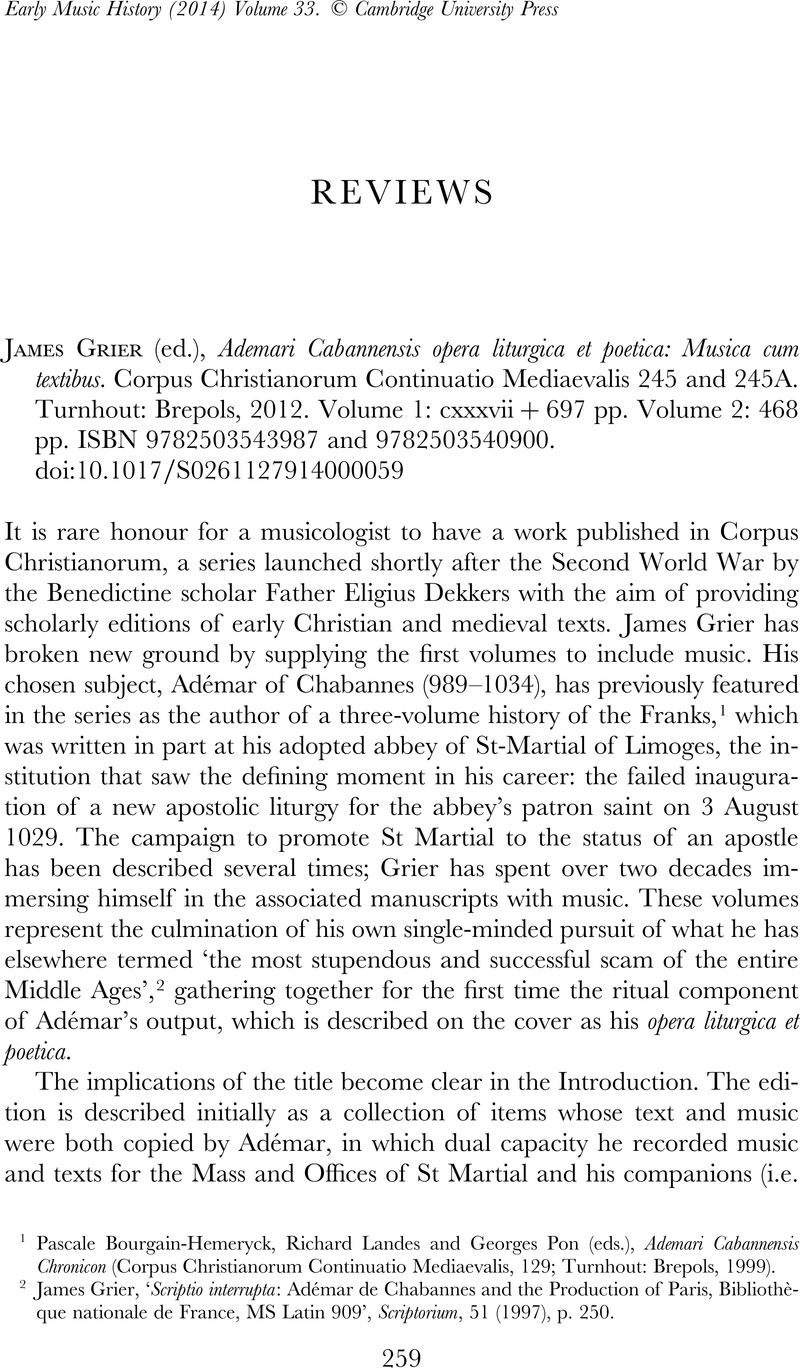No CrossRef data available.
Article contents
James Grier (ed.), Ademari Cabannensis opera liturgica et poetica: Musica cum textibus. Corpus Christianorum Continuatio Mediaevalis 245 and 245A. Turnhout: Brepols, 2012. Volume 1: cxxxvii+697 pp. Volume 2: 468 pp. ISBN 9782503543987 and 9782503540900.
Published online by Cambridge University Press: 29 August 2014
Abstract

- Type
- Reviews
- Information
- Copyright
- Copyright © Cambridge University Press 2014
References
1 Bourgain-Hemeryck, Pascale, Landes, Richard and Pon, Georges (eds.), Ademari Cabannensis Chronicon (Corpus Christianorum Continuatio Mediaevalis, 129; Turnhout: Brepols, 1999)Google Scholar.
2 Grier, James, ‘Scriptio interrupta: Adémar de Chabannes and the Production of Paris, Bibliothèque nationale de France, MS Latin 909’, Scriptorium, 51 (1997), p. 250CrossRefGoogle Scholar.
3 Reproductions of all but one of the manuscripts discussed in this review can be found on the Gallica website of the Bibliothèque nationale de France, <http://gallica.bnf.fr>. Plates of folios from the notated endleaves of Pa 1978 (fols. 102 and 103) can be found in Delisle, Léopold, ‘Notice sur les manuscrits originaux d'Adémar de Chabannes’, Notices et Extraits des Manuscrits de la Bibliothèque Nationale et Autres Bibliothèques, 35/1 (1896), between pp. 240 and 241Google Scholar, pl. VI (fol. 102v), and Grier, James, ‘The Musical Autographs of Adémar de Chabannes (989–1034)’, Early Music History, 24 (2005), pp. 125–68 at 161 (fol. 103r)CrossRefGoogle Scholar.
4 Emerson, John A., ‘Two Newly Identified Offices for Saints Valeria and Austriclinianus by Adémar de Chabannes (Ms Paris, Bibl. Nat., Latin 909, Fols. 79–85v)’, Speculum, 40 (1965), pp. 31–46CrossRefGoogle Scholar.
5 The sequence melodies attributed to Adémar are those for Mente pura (IXA. 24D), Per secula (24F), Alte vox canat (24G), Corde devoto (25C) and Coaequalis (25G).
6 The relevant passages of Nobis annua (III.2.A) are as follows: ‘via lux veritas … per tempora’ (5a), ‘preces et munera … per secula’ (5b), ‘Et piis precibus … peccamina’ (9a) and ‘Regna concede … tabernacula’. For these passages within the full sequence text Celsa polorum, see Die Prosen der Abtei St. Martial zu Limoges aus Troparien des 10. 11. und 12. Jahrhunderts, ed. Dreves, Guido M. (Analecta hymnica medii aevi (hereafter AH), 7; Leipzig: Fues, 1889), no. 199, pp. 218–20Google Scholar. For the same passages appearing as independent verses for an Alleluia for St Stephen, see Tropi graduales: Tropen des Missale im Mittelalter II. Tropen zum Proprium Missarum, ed. Blume, Clemens (AH 49; Leipzig: Fues, 1906), no. 529, p. 276Google Scholar.
7 The sections of Apostolorum gloriosa that are set apart by capital letters are as follows: ‘Te Christe … aula’ (5a), ‘Regnans sempiterna … summa’ (5b), ‘In carne … tua’ (9a), ‘Clara victoria … corda’ (9b), ‘Lux apostolorum … indulgentiam’ (13a), ‘Concede temporum … patriam’ (13b).
8 Jacobsson, Ritva M., Fêtes des saints et de la croix et de la transfiguration. B Edition, Corpus Troporum X (Tropes du propre de la messe, 5; Stockholm: Acta Universitatis Stockholmiensis, 2011), no. 1088 (p. 332)Google Scholar.
9 Grier, James, The Critical Editing of Music: History, Method, and Practice (Cambridge: Cambridge University Press, 1996), p. 174Google Scholar.
10 Grier, James, The Musical World of a Medieval Monk: Adémar de Chabannes in Eleventh-Century Aquitaine (Cambridge: Cambridge University Press, 2006)CrossRefGoogle Scholar.
11 For the use of a custos beginning with a rising diagonal stroke in conjunction with neumes not written by Adémar in Pa 909, see fols. 150r–157v; for a custos in the form of a dash added to an earlier Aquitanian manuscript by a notator other than Adémar, see Pa 1120, fol. 2v, where ‘e’ is also used.
12 The fundamental study of Adémar's text hand remains Delisle, ‘Notice sur les manuscrits originaux’, pp. 241–358. The most detailed palaeographic justification for identifying Adémar's text hand in the second layer of Pa 909 is to be found in Emerson, ‘Two Newly Identified Offices’, p. 34.
13 See, for example, the addition of text and neumes by a different hand from the fifth line of fol. 14r through to the second line of fol. 14v.
14 A liquescent single-note sign in a shape akin to a ‘7’ is introduced at this point, initially in place of the curved single-note sign used in the first gathering, although this curved sign returns later alongside the newly introduced ‘7’ sign. In addition, the clives signs begin to be written with a more sharply angled head; this difference in formation is again introduced alongside the previously more rounded form rather than simply replacing it.


